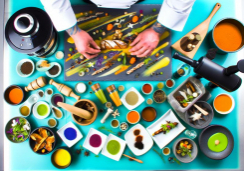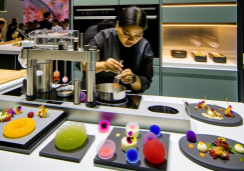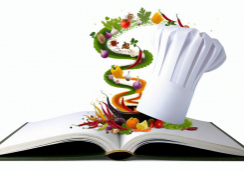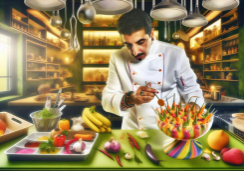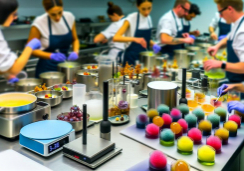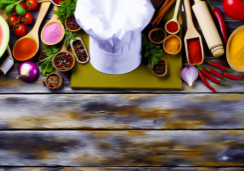Crafting Vibrant Vegan Dishes: Recipe Creation Secrets
In the world of culinary arts, creating a vibrant vegan dish requires a masterful blend of color, texture, and flavor. As a professional, you understand the nuances of recipe development and how to coax out rich, satisfying tastes from plant-based ingredients.
You'll find that the secrets to crafting these gourmet vegan dishes lie in understanding the symphony of spices and the alchemy of cooking methods tailored to fruits, vegetables, grains, and legumes. What you may not have considered, though, are the transformative techniques that can elevate a simple vegetable medley to an exquisite culinary experience.
Stick with me, as I guide you through a world where your kitchen becomes a canvas for nutritious artistry. Together, we'll uncover the subtleties that can turn your vegan dishes from mere meals into memorable feasts.
Exploring Plant-Based Flavors
Dive into the rich tapestry of plant-based flavors, where mastering the five basic tastes—sweet, sour, salty, bitter, and umami—transforms simple ingredients into culinary masterpieces. You're not just cooking; you're curating a symphony of flavors, each note carefully selected from the earth's bounty. Vegan ingredients become your palette, and vegan gastronomy your canvas.
In your quest for vibrant vegan dishes, discover the art of balancing these elemental tastes. Sweetness can be teased from caramelized onions, while citrus fruits impart a zesty sourness. Sea salt flakes evoke the ocean's embrace, and a hint of bitterness from kale or radicchio adds depth. Then there's umami—the savory richness often missed in plant-based meals. Nutritional yeast, tamari, and ripe tomatoes are your secret weapons here.
Overcoming the challenge of replicating meaty flavors, you innovate with smoky spices and hearty legumes. The visual feast is just as crucial; eat with your eyes first by splashing color with bell peppers, pomegranate seeds, or vibrant purées. Remember, constructing a satisfying vegan meal is an experience that extends beyond taste. Balance your dishes, set a welcoming table, and watch as your culinary creations become the heart of memorable moments.
Balancing Nutritional Profiles
While your palate dances with the symphony of flavors, let's ensure your body reaps the same joy by balancing the nutritional profiles of your vegan creations. The art of vegan cooking is more than just a medley of plant-based ingredients; it's a meticulous composition of the Building Blocks—carbohydrates, proteins, and fats—that harmonize to nourish you fully.
Imagine your dish as a canvas, with each color representing a vital nutrient your body craves. Vibrant vegetables and fruits infuse your meals with vitamins and minerals, whole grains bring the comforting embrace of carbohydrates, and the robust textures of beans, lentils, tofu, and tempeh inject the essential protein stanzas. These are the cornerstones that safeguard the benefits of a vegan diet, ensuring that each bite is as beneficial as it's delicious.
As an experienced culinary artist, you know that the method of preparation can be as influential as the ingredients themselves. Roast to enhance, grill to imbue smokiness, steam to preserve essence. Each technique is a brushstroke that maintains the nutritional integrity of your components.
Textural Contrasts in Vegan Cooking
Let your taste buds revel in the artistry of texture, where the crunch of a perfectly roasted chickpea meets the silkiness of a velvety avocado purée, presenting an essential layer of sophistication to your vegan dishes. Mastering textural contrasts in vegan cooking not only elevates the sensory experience but also infuses each bite with intrigue and depth.
Here's how to weave that magic into your culinary creations:
- Marry the Methods: Roast, sauté, and steam to diversify textures. A crispy roasted cauliflower floret atop a creamy carrot soup brings a captivating crunch that contrasts the soup's smooth embrace.
- Flavor Meets Feel: Pair tangy fermented kimchi with the soft embrace of a steamed bun. The piquancy dances with the dough's tender chew, creating dishes that sing with vibrancy.
- Harmonious Blending: Incorporate a medley of ingredients like nuts, seeds, and grains for a symphony of textures. A quinoa salad with crunchy pepitas and succulent tomatoes is a textural masterpiece.
- Crisp and Tender Tango: Balance crispy tofu cubes with a velvety spinach puree. The contrast ensures each mouthful is a satisfying exploration of vegan cooking's potential.
Embrace these strategies to craft dishes that aren't only visually stunning but a delight to the senses, showcasing the infinite possibilities within the canvas of vegan cuisine.
Aromatics and Spices Usage
Embark on a sensory journey through your vegan culinary landscape by skillfully layering aromatics and spices, the foundational elements that infuse your dishes with soul-stirring flavors.
Mastering the art of crafting vibrant vegan dishes hinges on your adept aromatics and spices usage. Begin with the basics, the holy trinity of vegan flavor: onions, garlic, and ginger. They're your canvas, awaiting the bold strokes of cumin's earthiness, paprika's smokiness, and turmeric's golden hue.
You're not just cooking; you're an alchemist transforming humble ingredients into gastronomic gold. Experiment with fearlessness, knowing that each spice has a story to tell. Coriander may whisper of citrus-filled markets, while a dash of cinnamon brings forth memories of autumnal comfort. Your dish is an anthology of these tales, each spice a chapter, each aromatic a character.
Balance is your mantra. Too much, and your dish shouts; too little, and it murmurs when it should sing. Find harmony in the contrasts, the push, and pull of flavors. With each taste, your diners should feel the vibrancy of your creation, the very essence of plant-based artistry, a testament to the rich tapestry woven through the intelligent aromatics and spices usage.
How Can I Incorporate Vegan Ingredients into My Unique Dish Creations?
When creating unique dishes, consider incorporating vegan ingredients to cater to a wider audience. Experiment with plant-based proteins like tofu or tempeh, and use creative seasoning combinations to elevate flavors. These culinary tips for unique dishes can inspire innovative and delicious vegan creations that everyone can enjoy.
Innovative Vegan Cooking Techniques
You're crafting more than just a meal; you're painting with the bold brushstrokes of flavor layering, an essential technique in the vegan culinary canvas.
As you orchestrate textural contrasts, your dishes sing with crunch and creaminess, whispering secrets of satisfaction in every bite.
Master these methods, and you'll transform plant-based ingredients into a symphony of taste and texture that captivates the senses.
Flavor Layering Essentials
Mastering the art of flavor layering can transform your vegan dishes from simple to sublime, starting with the strategic combination of the five basic tastes. Dive into plant-based cooking with flair, meshing sweet, sour, salty, bitter, and umami to craft a symphony on your palate. Here are your flavor layering essentials to elevate your culinary creations:
- Identify natural flavor sources: sweeteners, citrus, salts, greens, and umami-rich vegetables.
- Pair plant-based proteins with whole grains to build a robust foundational taste.
- Experiment with cooking techniques like roasting or grilling to intensify flavors.
- Concoct vibrant sauces and marinades, the recipe creation secrets to adding layers of complexity.
Embrace these artistic strategies, and watch as your vegan dishes blossom with rich, multi-dimensional tastes.
Textural Contrast Mastery
Delve into the art of textural contrast, where the crunch of a roasted chickpea can dance harmoniously with the creaminess of an avocado purée in your next vegan masterpiece.
Elevate your cooking by embracing the innovative techniques that bring textural contrast mastery to the forefront of your culinary creations. Picture vibrant vegan delights, where every bite is a symphony of sensations.
Experiment with plant-based proteins and grains, roasting to perfection, grilling for smokiness, and steaming for tenderness. Artfully combine the soft and crunchy, the creamy and crispy. Your palette will revel in the joy of harmonious contrasts, making each dish not just a meal, but an experience.
This is the essence of innovative vegan cooking—where texture is as crucial as taste.
Presentation and Plating Tips
You know that first impressions count, and in the culinary world, the eye feasts first.
Master the art of color contrast to make your dishes pop on the plate; think beetroot hummus as a vibrant base for your greens.
Leverage the allure of negative space and strategically chosen edible garnishes to turn a simple meal into a canvas of plant-based artistry.
Color Contrast Enhancement
Enhancing your vegan dishes with a kaleidoscope of colors not only tantalizes the taste buds but also turns each plate into a visual masterpiece.
As you delve into crafting vibrant vegan dishes, consider these artistic strategies for color contrast enhancement:
- Select ingredients with naturally vivid hues, like ruby-red bell peppers or verdant kale, to build a visually enticing palette.
- Pair complementary colors from the color wheel—think purple cabbage against a bright orange carrot puree—to create striking visual harmony.
- Embrace the use of negative space by arranging your components thoughtfully, allowing each color to pop.
- Integrate contrasting textures, such as creamy avocado with crunchy radishes, to add depth and interest to your presentation.
Each vegan recipe is your canvas—make it unforgettable.
Utilizing Negative Space
Mastering the art of negative space on your plate allows you to frame your vegan delights with intention, guiding the diner's eye to the star ingredients with striking simplicity.
As you delve into the recipe creation secrets of crafting vibrant vegan dishes, consider the power of utilizing negative space to enhance visual interest. It's not just about what's on the plate, but also what isn't.
This minimalist approach isn't mere emptiness; it's a canvas inviting contrast and focus, a technique to balance the positive with the negative, fostering a sense of harmony.
Edible Garnish Selection
Selecting the perfect edible garnish transforms a simple vegan dish into a vibrant masterpiece, marrying aesthetics with flavor. Your palette and platter deserve nothing less than a symphony of color and zest. Here's how to elevate your vegan dishes with an artistic touch of edible garnish selection:
- Fresh Herbs: Bright basil or delicate dill, fresh herbs not only add a burst of flavor but also a dash of greenery.
- Microgreens: A sprinkling of microgreens can introduce a subtle, earthy depth to your recipes.
- Edible Flowers: Use these natural beauties for a pop of color and a hint of unexpected taste.
- Citrus Zest: Grate some zest for a citrusy kick that'll contrast and complement the dish's main flavors.
Master these elements, and you'll create not just food, but art on a plate.
Conclusion
Unleash your inner chef and let your kitchen become a canvas for vibrant vegan masterpieces.
You've explored the robust symphony of plant-based flavors, balanced nutrition with gusto, and played with texture to create dishes that sing.
Infuse your creations with aromatic spices, embrace innovative techniques, and present each plate with flair.
Remember, every meal is an opportunity to nourish body and soul.
So go ahead, craft with passion, and let your vegan dishes dazzle the senses.

